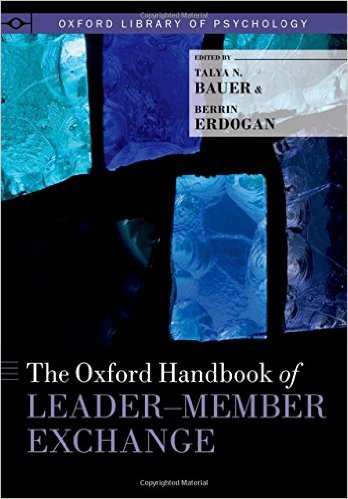 Editors: Talya N. Bauer, and Berrin Erdogan
Editors: Talya N. Bauer, and Berrin Erdogan
Publisher: Oxford University Press – 435 pages
Book Review by: Sonu Chandiram
Relationships in Leader-Member exchanges (LMX) are dyadic or based on mutual respect and equality between leaders and members of an entity, organization, or unit, the editors of this book point out. A dyad being a pair, the relationship between members is not based on any member of the pair having superiority over the other one. One example is a married couple. At least in most of the Western world, such a relationship is based on mutual consideration of each other’s needs.
There are many types of relationships in organizations and social groups in different spheres of society, such as business, education, government, the military, religious, etc. Typically the types of relationships that exist in different groups are based primarily on their purposes and goals.
For example, companies exist to make money for members (employers and employees), so harmony and teamwork are essential to achieve this purpose. Schools exist to impart information and insight; governments to maintain political and economic order; the military to protect residents from harm; and so on.
In all these above-mentioned spheres, typically there are two elements: leaders and members, to achieve their purposes and goals. Otherwise chaos could be (and oftentimes is) the result.
The type of relationship that exists between leaders and members in social groups is often based on leadership theory.
The editors point out on the inside jacket flap of this book: “Whereas contemporary leadership theories such as transformational, servant, or authentic leadership theories focus on the effects of leader behaviors on employee attitudes, motivation, and team outcomes, relational leadership theory views the dyadic relationship quality between leaders and members as the key to understanding leader effects on members, teams, and organizations. This approach views the trust- and respect-based relationships as the cornerstone of leadership.”
Forty-four people including the editors, in 26 universities located in seven countries – mainly the United States, as well as Australia, Germany, the Netherlands, and the United Kingdom – authored the 22 chapters of this book which is focused on leader-member exchanges. This book is organized into five Parts, namely:
- Part One – Foundations of Leader-Member Exchange (LMX)
- Part Two – Antecedents of LMX
- Part Three – Consequences of LMX
- Part Four – LMX Beyond the Dyad
- Part Five – Issues in LMX
The study of LMX arose out of a theory in the 1970s and has grown into an entire area of research. Interest in it has increased rapidly in the past four decades. The editors and authors of this book do the following:
- Take stock of the literature to examine its roots
- Inform us what is currently known
- Investigate what research gaps may exist
- Point out what areas are in most need of research
As you look into the various chapters, you get the gist of each in the Abstract presented on the first page just below the chapter title and author bylines.
If you are dismayed at the growing amount of political conflict around the world that has resulted in the death and displacement of millions of people, you ask yourself, why can’t people respect one another and just get along instead of killing one another?
The answer may very well lie in the results achieved through LMX relationships. In the Abstract of chapter 1, Leader-Member Exchange (LMX) Theory: An Introduction and Overview, the authors Talya N. Bauer and Berrin Erdogan write:
“Leader-Member Exchange (LMX) is the foremost, dyadic relational approach to leadership. Findings in LMX show that leaders are more inclusive and communicative with some members compared to others. Thus leaders form high-quality, trust, affect and respect-based relationships with a subset of their team, whereas they tend to have a lower-quality social exchange that is limited to the employee and the leader’s job description with other members.”
The superior results achieved in relationships using LMX – which is based on more inclusion and communication, mutual respect, and consideration for one another – provide us the crucial keys to ending conflict not only on the international level, but also at all other levels: regional national and local.
Editors:
Talya N. Bauer, PhD (Purdue University) and Berrin Erdogan, PhD (University of Illinois, Chicago, are Fellows of SIOP. Both are well-known scholars-in-the area of Leader-Members Exchange (LMX). Since 1996 they have been engaged in understanding how LMX relationships form, develop and evolve.
In addition, they have examined important boundary conditions related to understanding LMX. Talya serves as an Associate Editor for the Journal of Applied Psychology and Berrin serves as an Associate Editor for Personnel Psychology.







